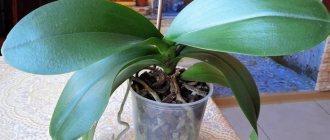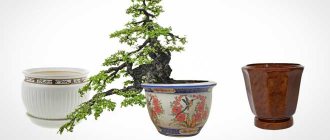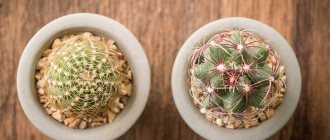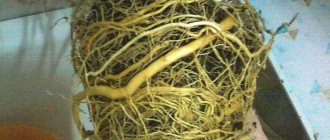Selecting container and soil
Selection of container:
Cacti are quite demanding on the container in which they will grow. The size of the pot should match the root system of the cactus. To choose the right pot , you need to remove the cactus from the old container, carefully straighten the roots and inspect the root system. In some cacti, the roots are better developed in the upper part and are not very long, then the pot should be wide enough, but not deep. In other cacti, the roots grow in length, especially if the root system has a main taproot, then the pot should be deep , but not wide. In any case, the volume of a pot or other container for planting should not greatly exceed the volume of the root system in a straightened form, but it must be taken into account that some space in the pot will be taken up by drainage.
brown spots have appeared on it , or has been damaged in some way, then the dishes should be slightly smaller in size than the volume of the root system. Also, when choosing a container, you should take into account the growth pattern of cacti. For example, mammillaria form many children and many plants are obtained in one pot, so they need wider pots, but not deep ones (see picture). But for Ariocarpus, for example, the container should be deeper than wide.
What material the container for growing a cactus is a matter of taste. Cacti are usually grown in plastic pots, but they can also be grown in clay pots, plastic yogurt cups, ceramic cups, coconut shells, etc. It is undesirable to grow cacti only in metal containers, which can rust, and this will adversely affect the plant.
If there are a lot of cacti and the collection is growing, then it is quite convenient to plant the cacti in square or rectangular containers, which are then placed easily and tightly together on a common tray; this makes it easier to carry the cacti; the tightly arranged pots occupy a stable position. the frequency of watering depends on what material the container is made of . In plastic dishes, the earth retains moisture longer than in clay ones.
Another condition for containers for cacti is drainage holes. I would say that this is a mandatory condition, since cacti really do not like stagnant water in a pot (especially epiphytes). Water that remains in the roots can lead to rotting and death of the plant.
The soil:
Preparing soil for replanting cacti is a complex and controversial issue, in the sense that the composition of the soil depends on many factors, for example, the type of cactus, its age, etc. Different literature provides different recipes and methods for preparing soil for cacti. Despite the fact that they sometimes differ, each author who recommends one or another soil recipe, as a rule, relies on his own experience, which has had good results. The ingredients included in traditional cactus soils are varied, but always the same, these are:
| Ingredients | Properties | Where to get them |
| Leaf ground | rich in nutrients, loose, light, easily absorbs water | In the spring (April), when the snow is just melting in any birch grove or park where there are deciduous trees, the snow, old leaves are raked and the earth is collected with a scoop |
| Clay-turf soil | holds water firmly, and nutrients are washed out of it more slowly | Near the garden, where the ground is overgrown with turf (dense grass), this turf is removed along with the soil with a shovel and laid in layers that can be shed with slurry, then covered and left for at least one year. If this technology is difficult for you, then you can get this soil differently. You need to dig up the turf and, holding the grass, thoroughly shake off the soil from its roots. In this case, it will not be as nutritious as if it had been pressed for a year, but the structure will meet the requirements. |
| Old greenhouse land | used when it is not possible to obtain leafy and clay-turf soil | In the vegetable garden |
| Well-rotted manure (humus) | used in limited quantities to add to very nutrient-poor soil | In the spring, cow manure in the garden or vegetable garden is placed in a tank or compost pit and covered with leaves (birch or apple) and soil, then dug up and used the next spring. |
| Coarse river sand | gives the soil looseness and porosity, is an essential component in any soil for all cacti | On the river, on the beach, be sure to wash well |
| Charcoal | (only deciduous trees), used for disinfection in powder form (sprinkled on wounded roots) and added in pieces to the soil, because has anti-putrefactive properties | Burn any stick made of deciduous trees in the garden or vacant lot, preferably birch, break the firebrand into pieces. Crush some into powder, and leave some in small pieces and add to the soil. |
| Brick chips | Gives the soil looseness and porosity, has the ability to retain excess moisture | Use a hammer to crush red bricks into crumbs, which can be found wandering around the city or at the nearest construction site |
Before choosing a particular soil mixture, you need to know that in any case, it must meet the following requirements:
- the soil for any cacti should be loose, easily allow water and air to pass through,
- The acidity of the soil for almost all cacti should be slightly acidic, better than pH = 4.5 - 6.
You need to know that leaf soil is looser than clay-turf and greenhouse soil. Brick chips and river sand give the soil looseness. And to give the soil the necessary acidity, add either peat (to increase acidity) or lime (gives an alkaline reaction and reduces acidity). It should be borne in mind that young cacti and prickly seedlings need looser and more nutritious soil, so leaf soil makes up a significant proportion of the soil mixture for them.
Adult and old cacti need denser soil, so they take more greenhouse and clay-turf soil. For fast-growing cacti, humus is added to the soil mixture. What else will the composition of the soil mixture depend on? Depending on the species characteristics of the plant, for example, cacti that have absolutely no spines need less calcium in the soil than cacti richly decorated with spines, which benefit from adding crushed, crushed eggshells to the soil.
Landing
Cacti reproduce in three ways.
Children
Planting by children is most common because of its simplicity. To do this, you need to adhere to certain actions.
- Separate the baby (lateral process). Some of them may fall off on their own over time. If this does not happen, you will have to separate it with a knife. This must be done with caution so that no foreign pieces remain on the adult or baby cactus, which may subsequently rot.
- If there are no roots for the children, they need to be grown. First, the baby is put aside for several days so that the cut dries. Then wet sand or water is poured into a narrow bowl, and the baby is placed so that there is no direct contact with moisture. Putting babies directly into water is risky because they can rot.
- The baby with roots can be planted in a pot. To begin with, it should not be large - only a few centimeters larger than the diameter of the baby. For planting, take a pot with prepared soil mixture, as described above. Then a small depression is made in the center, into which the roots of the cactus descend to the border of its neck. The soil around should be compacted a little.
- To keep the cactus straighter and its neck not to be in the ground, you need to sprinkle some drainage stones on top , for example, expanded clay.
Cuttings
Planting cuttings is a little similar to the previous method. For cuttings, you can take the top part of a cactus. It should not be too short, because the substances accumulated in it should be enough for growth. In this way you can revive a broken plant. The procedure in this case will be as follows:
- after separating the top, the cut on the cactus can be left as is or powdered with crushed charcoal;
- the cut needs to be trimmed slightly into a cone shape; it must air dry, which can take up to 10 days;
- then you need to treat it like children who do not have roots - fix it in a vertical position above wet soil or water;
- After the roots appear, we begin planting.
Seeds
Growing cacti from seeds is the most difficult. Even professionals have a certain percentage of losses. For amateurs it will be very high. However, over time, you can take into account your previous experience and delve into the intricacies of this matter in more detail. To germinate seeds, you must follow these steps:
- treat the seeds with potassium permanganate; the ground must be disinfected with steam or boiling water;
- soil is poured into a shallow but spacious container with numerous holes in the bottom, then seeds are laid on top in rows;
- to prevent the seeds from moving, watering should only be from below;
- the entire structure must be covered with any transparent material (film, plastic or glass).
After germination, seed residues must be removed. And the first stage of picking begins. They need to be carefully moved to another container with proper soil and good drainage. It happens like this:
- With any available tool, a symbolic groove should be drawn in the ground;
- with minimal deepening, you need to plant sprouted cacti in them - for this it is better to use tweezers.
This is interesting: Ivy-leaved (ampeloid) geranium: home care, cultivation
What do cactus seeds look like?
Many novice cactus growers are interested in whether it is possible to grow a cactus from seeds? The answer is clear: it is not only possible, but also necessary, because seed propagation is the most complete way to replenish the collection, but it requires quite a lot of time.
In addition, this is the cheapest option for creating your own collection. Of course, you can buy already grown plants, but here a novice cactus grower will face many pitfalls and disappointments. Purchased specimens may be affected by pests and rot, and cacti grown with fertilizers stubbornly refuse to grow in ordinary soil. In addition, cacti that have been in stores for a long time with a lack of light often have stems that are hopelessly damaged. Finally, the attitude towards these cacti will be completely different than towards plants grown by yourself. Before planting cacti, you need to get the seeds from somewhere. Purchasing planting material will not cause much difficulty. They can be bought in clubs for cactus lovers, borrowed from friends, ordered from private catalogs, and finally purchased via the Internet.
So, what do cactus seeds look like? According to the current definition, a seed is a fertilized mature ovule that has an embryo, reserve nutrients and a protective shell. The seed embryo is divided into an embryonic root, a subcotyledon (hypocotyl), which is part of the stem, an embryonic bud and cotyledons, the number of which in cacti is usually two.
The rest of the seed is filled with a nutrient substance called endosperm. On the shell you can distinguish a hilum - the place where the seed is attached and a micropyle - a narrow channel through which the pollen tube penetrates and fertilization occurs. When seeds germinate, the root elongates and penetrates into the soil. At the beginning of germination, all cells of the embryo divide, but after the formation of the seedling, cell division is localized at the tips of the shoot and root.
The lifespan of plant seeds, including Cactaceae, varies greatly. For example, there is a known case when lupine seeds from the Arctic tundra, after lying in frozen silt for about 10 thousand years, germinated well. Cactus seeds have different life spans.
The seeds of rebutia, ailostera and some other genera have a short life. The period for germination of cacti from such seeds is limited to approximately one year. Conversely, in representatives of the genus Cereus and Mammillaria, the lifespan of seeds can reach 7-9 years. Longer-living seeds are also known. In addition to biological reasons, the lifespan of seeds depends on their storage conditions. There are two independent rules for storing seeds: 1) with an increase in water in seeds by 1% (with an optimum of 5-14%), their lifespan is reduced by 2 times. At the same time, below the optimum, oxidation of seed fats occurs, above the optimum, fungal damage occurs; 2) with an increase in temperature for every 5 °C (in the range of 0-50 °C), the lifespan of seeds is also reduced by 2 times. In other words, so that cactus seeds do not lose their viability, it is advisable to store them in the optimal range of temperatures and humidity, without changing these parameters if possible. For cactus seeds, a good place to store seeds is on the shelf on the door of your home refrigerator.
How cacti grow from seeds in winter
Before transferring to wintering, watering is gradually reduced. After the last watering, the soil is dried and the seedlings are placed in a cool place designated for wintering. The top additional shelf on the window is best suited for this. This shelf provides a higher temperature than on the windowsill, which is important for young plants.
To prevent excessive loss of water by seedlings and contamination with dust, they should be kept on trays covered with glass covers. At first, especially on sunny days, the caps may fog up in the evening, since the plants have not yet completely entered a dormant state, and there is residual moisture in the soil. Fogged caps must be removed to dry.
Wintering of seedlings lasts two months - January and February. In the first year of life this is quite enough. It is necessary to regularly monitor the condition of the seedlings during wintering, and if some of them are too wilted, the soil should be slightly moistened. As a rule, such wintering does not cause problems. In March, with an increase in the number of sunny days and window temperatures, the seedlings begin to be sprayed, and with the appearance of fresh thorns, they begin to be watered. Seedlings that have begun to grow are transplanted into fresh soil. Good results are obtained by growing young plants in the second year of life in common boxes.
When grown together in a large volume of soil, they grow more vigorously than plants planted in individual pots. By the end of the growing season, large specimens of certain species may be quite suitable for transplanting into individual pots to replenish the collection.
Light and temperature
When growing cacti, you need to remember that they are light-loving plants. Lack of light leads to deformation of stems, underdevelopment, and plant diseases. Cacti love south windows. Place them in the brightest sunny location. Some people from deserts, as well as cacti grown on northern windows, require additional lighting with fluorescent lamps in winter
For a better understanding of all the life processes of these prickly creatures, we recommend acquiring serious, high-quality literature about cacti.
If the top of the cactus begins to stretch out and become thinner, it means that it does not have enough light.
Most cacti do not suffer from bright sunlight; in summer, rhipsalis and other tropical forest plants need to be carefully protected from direct sunlight. In summer, provide ventilation and fresh air to the cacti by placing them on a balcony or in a window box, but do not forget to cover them with plastic wrap in rainy weather.
In winter, in apartments with steam heating, cacti suffer from high temperatures and dry air. Place them on a light window between the frames or on a windowsill protected from steam heating radiators with plexiglass. Epiphytic species of cacti are kept in a warmer place in winter.
Wash your windows more often; city dirt settling on the glass greatly reduces the passage of light.
Protect cacti from drafts. Slots in the frames will, of course, lower winter temperatures on your windowsill, but this is not a solution to the problem of cold wintering.
Don't change the location of the cactus unless absolutely necessary, they don't like it. Do not turn the cactus around its axis to make it grow more evenly. In both cases, you may lose the long-awaited flowering. And even more so, there is no need to rearrange a cactus that is gathering buds. In order to always know, and in case of a forced rearrangement, not to be mistaken, which side a given specimen was facing the light, you should make marks on the pots.
Fresh air is much more important for cacti than for most other plants. Many cacti may not bloom only because they do not have enough fresh air. Therefore, in the summer it is better to place them on the balcony or veranda. At the same time, care must be taken to ensure that they are protected from dust, wind and rain. If the balcony is glazed, then the cacti are provided with both shelter and fresh air, and if not, then you can make a canopy over the shelf with the cacti from a light-transmitting material, for example, from a greenhouse film. If there are a lot of cacti, then it is best to put the pots on one common tray, so they are easier to transport.
Ideally, it would be good to gradually accustom cacti to the street, and leave them in the fresh air around the clock until the end of summer and even until the beginning of autumn. Accustoming cacti to night temperature changes helps strengthen the skin on the plant stem; the hardening procedure prepares it for a cold winter. Such cacti are distinguished by shiny spines, bloom better and easier, and have greater resistance to disease. However, with all the love of cacti for fresh air, drafts can be destructive for them.
Diseases and pests
One type of rotting is the defeat of a cactus by white spotting.
Cacti are quite hardy, but in our climate they can face two dangers - a lack of essential minerals and fungus. The first often leads to withering of the shoots and the appearance of yellowness on them. Usually, dealing with yellowness is very simple - correct the watering regime and apply fertilizing.
The fungus can manifest itself in different ways. Often, the rotting of a cactus is also associated precisely with the activity of the fungus. The main reason for these phenomena is excess moisture in the substrate and air. Many people forget that the cactus is a desert plant and should not be watered like ordinary indoor flowers. You also need to follow a simple rule: the air in the room with cacti should not be too humid.
If rot appears on cacti, it is recommended to follow the following instructions:
- Remove the cactus from the substrate
- Remove all damaged areas
- Treat the cut with crushed charcoal
- Transplant the plants into a new substrate that has been disinfected in advance (for example, by heating in the oven or treating with potassium permanganate)
You can detect a mealybug by traces of its vital activity - small white lumps
It should be said right away that the likelihood of success with such events is relatively low. As a rule, to preserve the variety and ensure that the fungus is eliminated, the entire plant is destroyed, leaving only the tips of the shoots or ripe children.
Cacti have relatively few pests. Despite the high attractiveness of the delicate plant tissues for caterpillars, local species, as a rule, are not interested in cacti. Even plants planted in the garden are rarely attacked by caterpillars or slugs.
The main threat to cacti comes from two species: root bugs and hairy aphids. The scale insect is a small insect that lives in the substrate and damages the roots of the plant.
The hairy aphid is a close relative of the mealybug (in fact, another name for aphids is the stem mealybug), but it lives on the shoots of the plant.
Cactus affected by hairy aphids
This pest causes numerous wounds to the plant, making punctures in the stems and feeding on cactus juice. With a large number of this arthropod, cacti may even begin to fall off their spines. In addition, through the holes that the mite makes in the plant shell, fungal spores can enter it, which leads to the formation of areas of rotting.
To combat both types of scale insects, special anti-tick agents are used - acaricides. The best drugs for this purpose are Actara or Actellik.
There is also a way to get rid of these pests without using chemicals. To do this, the cactus is removed from the soil, the remaining soil is washed off and immersed in water at a temperature of 50-60° degrees for 10 minutes. After which it is dried for several days and transplanted into a new substrate. Just as in the case of fungus, it is advisable to disinfect the substrate.
It is recommended to carry out preventive treatment of the plant against ticks twice a year.
Drainage for cactus
For cacti, drainage is simply necessary. Even drainage holes will not prevent stagnation of water in the roots, because excess water remains in the pan, from where there is not always time to drain it. Good drainage will certainly protect the cactus from stagnation of water. The dimensions of the drainage are relative - at least 1/6 of the volume of the pot, maximum - 1/3. For drainage, you can use expanded clay, small pieces of broken red brick, small crushed stone, and, for lack of a better option, pieces of foam plastic.
Broken egg shells are also added to the drainage. Preferably for drainage, or you can simply add pieces of charcoal (preferably birch) to the soil mixture.
Replanting instructions - expert advice
When replanting, great care should be taken, as the slightest scratch can lead to the death of the plant. If the root system is damaged, the process of rotting may begin upon contact with wet soil. As a result, the flower will die.
The operation is performed in three stages:
- preparing the cactus, soil and pot;
- performing a root bath;
- moving the flower.
How to prepare a plant
To facilitate the process of removing a flower from a pot, stop watering it three days before the procedure. This time is enough for the soil to dry well. First remove the top layer of soil, then turn the container over and take out the plant. It is easier to remove an earthen lump with rhizomes if you tap the bottom of the flowerpot on the table.
Do not pull the plant out of the container using force. This leads to the tearing off of young, thin roots that cling tenaciously to the walls of the pot.
If the previous soil was light and loose, then the cactus will come out of the bowl without much effort. It is more difficult to get a plant from a clay mixture diluted with unwashed sand. Over time, such a substrate hardens and becomes like cement. The soil compacts and almost does not fall off the roots, forming a dense lump. To free the root system from the soil, place the lump with the rhizome in warm water and wait until it softens. Next, the roots are washed under a clean stream of water and dried for 10 hours. It is more convenient to hang the cactus to dry to avoid caking.
After freeing from the remaining soil, the rhizomes should be carefully examined. They must be healthy, without signs of rot or pest damage. All suspicious areas are cut back to intact tissue with a sharp knife disinfected with alcohol. The cut is sprinkled with sulfur powder or crushed activated carbon and dried.
Among soil-borne harmful insects, it is easy to detect the root mealybug by its cotton wool-like whitish secretions. If a pest is identified, you should wash the roots under clean running water until the white coating is completely washed off.
When replanting a succulent, a hot root bath is performed for prevention and treatment. To do this, make a stand from cardboard, in the middle of which a hole is cut. Next, they place a cactus on it. The roots are passed through a hole and immersed for 15-20 minutes in water heated to 50-55 degrees.
This time is enough to stimulate the further development and growth of not only healthy plants, but also those with signs of disease. Then the flower is dried in a suspended state for 3-4 days. Sometimes healthy-looking cacti do not grow or bloom. Root baths are an excellent way to start the necessary processes.
Proper transplantation is the key to longevity
Before you begin transplantation work, you need to prepare yourself so as not to prick yourself with needles. Usually they use gloves made of dense, strong material: leather, leatherette or rubber. Alternatively, newspaper or paper folded several times or a couple of pieces of foam rubber are suitable. This protection is suitable for replanting large specimens. You can purchase special pliers that will help you hold small succulents.
Here's what the procedure looks like step by step:
- Stop watering three days before.
- When the soil dries, remove the cactus from the pot.
- They free the rhizomes from the ground, make a hot bath for them and dry them.
- A clay shard is placed at the bottom of the prepared container and drainage from fine gravel is poured. The thickness of the layer depends on the size of the pot. This procedure is necessary to avoid moisture stagnation harmful to the roots.
- The next layer is a little soil.
- Place the plant at the same depth in the center as it grew in the previous flowerpot. The root neck should be on the surface. The roots are distributed evenly in a circle and the soil mixture is gradually covered.
- When the container is filled, vigorously knock on its sides so that the substrate is well distributed between the roots. Then lightly press the soil from above. Do not tamp too hard, as this can lead to compaction of the soil.
- A layer of decorative crushed stone or expanded clay is laid out on the surface; small pebbles, shells, etc. can be used.
If, when replanting a cactus, it was not possible to avoid needles getting into the skin, then measures are taken depending on their size. Large needles are removed using clean tweezers. It is more difficult to get small, numerous prickly pear spines with hooked outgrowths. When they come into contact with the skin, they are absorbed in hundreds. If you rub with your palm or wash your hands, the needles penetrate even deeper into the skin.
In this case, melted wax, which needs to be dripped from a burning candle, will help. Place your hand under running cold water to harden. Then remove the waxy crust along with the spines frozen in it.
Fertilizing cactus
There are many different points of view regarding feeding cacti with fertilizers. This is a rather controversial issue and, as a rule, it is based on someone else's experience. Since cacti are very unique plants, fertilizers are special for them. First of all, they differ in that they contain much less nitrogen.
In cacti, the need for nitrogen is extremely limited due to certain physiological characteristics. If there is a lot of nitrogen in the soil, or a lot of nitrogen is in the applied fertilizer, then the cactus stem begins to grow quickly, becomes loose and watery. Many children and offspring appear, but they do not develop into full-fledged plants; the skin of the cactus does not have time to grow and bursts. Wounds and scars appear that rot or become crusty, and as a result the plant will be disfigured or die. Therefore, organic fertilizers are not used for cacti, except in very small doses for epiphytic, fast-growing cacti.
Cacti need phosphorus and calcium more; plants also need potassium during flowering. It is best to use special fertilizers for fertilizing cacti, which are now on sale almost everywhere.
These include “Cactus”
– special concentrated liquid
humic fertilizer
, contains auxins, cytokinins, vitamins B, C, humic acids, nitrogen, phosphorus, potassium. Promotes growth, rooting, flowering, increases resistance to disease. Available in 0.5 liter bottles. Forest cacti - during the period of budding and flowering, 2 caps (8-10 ml) of fertilizer are diluted in 1 liter of water and watered after each watering. Desert cacti - 1 cap per 2 liters of water - water once every two weeks from March to October. Do not use during rest period. Feeding begins no earlier than two weeks after transplantation.
This is important: Since flowering in cacti does not always coincide with the growth period, do not feed your cacti with anything during flowering in winter. You can start feeding cacti only with the onset of the growth period - late March, early April. Fertilizing should be completed before the dormant period begins, i.e. in September. Winter-blooming cacti do not require additional feeding, since the plant itself does not grow, so watering is only slightly increased.
Care
The very first question that arises for everyone who has purchased a plant: “How to grow a cactus correctly?” There is nothing complicated here, the main thing is to follow the basic principles: water correctly, create the necessary temperature conditions, make sure that the plant receives the required amount of light, etc. Everything is extremely simple, which is why many novice gardeners choose a cactus as their “firstborn”.
Lighting and location
Typically, cacti are placed on window sills on the south or southeast side, where they receive the required amount of light.
It is very important that the plant is not exposed to direct sunlight, which can be harmful. This is especially true for those species that belong to the forest - they are accustomed to growing in partial shade, so the sun is destructive for them. It is worth remembering the period of adaptation. You cannot immediately expose the cactus to the street; first, it must be hardened for three weeks - in the fresh air during the day, at home at night. And, depending on the family and species, some plants may require artificial lighting in winter.
Temperature
And although in their natural environment, cacti grow under the scorching sun, house plants do not like it too much.
- In the hottest time of the year - summer, the cactus will feel quite comfortable at temperatures up to 30 degrees, but for some species, this mark can reach 33-35.
- Also, during this period, it is necessary to take the plant outside or to a ventilated balcony (loggia) so that it can breathe fresh air.
- Late autumn, winter and early spring are usually cool months, and for this time, the cactus needs to provide a temperature of 8 to 16 degrees Celsius.
Ventilation
When the container with the sown seeds is in the greenhouse, it must be ventilated regularly. At first, it should be light but frequent ventilation for several minutes. Next, you need to start leaving a small gap in the greenhouse in order to ensure a constant flow of air. And when the seedlings become stronger and larger, the greenhouse may not be used at all.
This is interesting: Transplanting an azalea: how to properly transplant a flower at home after purchasing and flowering
Picking
Time passes, the cacti grow. And very soon they will become cramped in the tray in which they were put. Here you will need to pick into a new container, where it is important to increase the distance between plants. Three to four such transplants may be required. When the cacti look more mature, they can be planted in special pots.
So simply, with minimal cost, you can grow any cactus that you dreamed of, but could not find for sale in the store. It is very interesting to watch the growth of a plant from scratch.
Watering
Another fairly common question is: “How often should a cactus be watered?”
Typically, people who are unaware or new to it either water the plant too often or not at all. Both of them are wrong here. Watering must be correct and timely, and for this you need:
- Avoid overflowing and water accumulation in the pot tray;
- Under no circumstances should you water with cold water. The temperature should be 11-15 degrees Celsius;
- Watering should be carried out as moisture is absorbed, but do not let the soil dry out completely;
- During the dormant period (late autumn - early spring), watering should be carried out 1-2 times a month with a small amount of water, and in the summer - 3-4, in the morning or after sunset. Again, test the soil dryness with your finger before watering;
- The pot where the cactus grows must have drainage, otherwise, due to constant moisture, the roots will rot and the plant will die;
- Water only the ground, try not to pour water on the stem, especially in winter.
In general, if you adhere to these points, there will be no problems. The only thing is that there are varieties of cacti that like more or less abundant watering - this is also worth taking into account.
Top dressing
Typically, fertilizing is carried out once a year, from March to September, sometimes during the flowering period, but not during the dormant period. The exception is the Decembrist cactus, which blooms in winter. It is better to use mineral fertilizers for cactus, low in nitrogen (this is important) and enriched in potassium and phosphorus. Oversaturation with nitrogen will disrupt the correct development of the plant. Flower shops sell various ready-made mixtures for fertilizing, where you can also consult in what proportions and how often it should be produced.
Replanting a cactus
The ideal time for transplantation is the end of March - May. Young cacti growing in small and cramped containers should be replanted annually. Replant large plants after 2-3 years, but regularly replace the top layer of old soil with fresh soil without damaging the roots. Replanting is necessary for cacti, since shaking the soil provides air flow to the roots and has a beneficial effect on the development of the plant. The pot for replanting the cactus must match the structure and size of the root system.
Do not take dishes that are too large, as this will delay the development of the plant; the soil undeveloped by the roots will turn sour. A pot is considered suitable if the previous one fits freely into it.
3-5 days before replanting, stop watering the plant so that the soil dries out and the roots can be easily separated from the old soil. The soil mixture for cacti is selected based on the biological characteristics of the root systems.
The soil should be loose, easily allowing moisture and air to pass through to the roots, rich in minerals, but not containing organic fertilizers. For most types of cacti, a mixture of leaf, clay-turf, peat soil, coarse sand in equal proportions with small pieces of charcoal is suitable. Sprinkle the prepared soil with granulated superphosphate and mix well. Most cacti prefer slightly acidic soil with a pH of no more than 6-6.5.
The individual characteristics of some species require additions to the standard mixture: plants with strong spines and abundant fluff need more lime, epiphytic cacti and echinopsis need a little rotted cow manure, columnar cereus need more turf soil and crushed stone.
To create the effect of calcareous rocks, i.e., as lime, crushed limestone or marble is added to the soil mixture. The most accessible lime material is old chipped plaster. Fresh lime cannot be added to the soil!
Online store “Labyrinth” – Your guide through the labyrinth of books about succulents and cacti
Cacti with tap and turnip roots naturally grow on clay soil. In indoor conditions, the soil for them should be dense, but water should not be allowed to stagnate in the pot. Therefore, weathered or frozen clay is added to the earthen mixture, which crumbles in the hands when squeezed. You can collect such clay from the ruins of old buildings or in nature, on mountain slopes.
The soil is watered in advance; it should not be very wet before transplanting. It is convenient to carry out the transplant as follows. Cover the holes for water drainage in the pot with shards, lay on top a layer of broken crushed stone, pieces of charcoal, coarse sand in a layer of 2-3 cm, and then an earthen mixture in a layer of 2-2.5 cm or more, in accordance with the characteristics of the root system. Place the plant prepared for replanting on a hillock of soil in the center of the pot and straighten the roots.
Gradually fill the gaps between the walls of the pot and the roots with soil, shaking the pot. This promotes even distribution of soil between the roots. Then, if the pot is small, press the soil with your fingers; if it is large, compact it with a flat wooden spatula. Add soil to the level of the root collar so that the entire green part of the stem is above the surface of the ground. Sprinkle sand or small gravel over the entire surface of the pot in a layer of 1-1.5 cm, which will prevent the stem from rotting.
Cover the transplanted cacti with a glass jar or plastic cap and water for 3-4 days. Cacti cannot be replanted during the period of budding and flowering.
The buds will fall off or degenerate. To avoid frequent transplants, which are poorly tolerated by some types of cacti, fertilizing with an infusion of superphosphate or a special store-bought liquid fertilizer for cacti will help. Feed in a dark place no more than twice a month. Before doing this, water the plant with water. Do not feed cacti that you are going to transplant or newly transplanted plants.
Special treatment method
(or root bath) for cacti with damaged root systems, used during replanting. It happens that a cactus is apparently healthy, but grows very poorly, and the roots turn out to be poorly developed and weak when transplanted. Then you can try the following procedure. After the cactus is removed from the pot, shake off the old soil; you can even wash the roots in warm water, but carefully so that there are no breaks. Then hot water is poured into a cup or glass, at a temperature of about 50-55 °C. For this you will need a thermometer. A dense material is taken and fixed to a glass above the water.
A hole is made in the middle and a cactus is placed there, while the roots up to the root collar should be in hot water, but neither the stem nor the root collar should touch the water. The cactus is kept in this hot water for up to 15 minutes. It is important that the water does not cool down, but is at the same temperature all the time; you can wrap the glass in a woolen shawl, or add hot water, monitoring the temperature with a thermometer, but under no circumstances should you cover the glass with the cactus. This procedure stimulates root formation in cacti. After this, the cactus roots must be dried for 12-24 hours, and then planted according to all the rules.
Features of cacti as plants
These representatives of the flora belong to succulent plants. That is, they are able to accumulate moisture in their powerful stem. Unlike other green organisms, they do not have leaves. The shoots are covered with hard or soft spines involved in photosynthesis.
The Cactus family is numerous, with over 2 thousand species, which are combined into 300 genera. America is considered the birthplace and main place of growth. Mexico, Chile, Argentina, Sri Lanka are rich in various species. They grow in arid desert areas and tropical jungles. Succulents survive in extreme conditions.
The trunk, also called the body, can grow to enormous sizes in the wild. The height of the stems sometimes reaches 10 m. The highest height recorded by scientists was 19 m.
The shoots grow very slowly, the annual growth is usually small. Along with giant succulents, there are also miniature specimens. The diameter of the Blossfeldia cactus reaches 1 cm.
Thorns are needed not only for protection from predatory animals, but also for protection from the sun. No matter how thick the spines are, they cast a shadow on the trunk. The thicker the layer the shoots are covered, the higher the preparedness for the scorching sun.
The skin is dense, practically impermeable to gases and liquids. Pubescence often plays the role of an absorbent sponge.
Another interesting feature of most species is that the thorny bushes do not form inflorescences; the flowers do not have a peduncle. The flower acts as a continuation of the stem. With excess feeding, some growing buds change into babies.
Flowering for these representatives of the flora is an unstable phenomenon. Some specimens bloom annually, others very rarely and only under very favorable conditions.
Some varieties are covered with flowers all over the top, creating a cap. The duration of flowering also varies. While some specimens have flowers that last for several weeks, others may close after a few hours.
Depending on the species, plants take on different shapes. The trunks are wrinkled, with ribs and tubercles. The ribs can be pronounced or barely noticeable, smooth or spiral-shaped. Plants are covered with different spines: dense, sparse, long, short, soft or hard.
A person needs to be careful with thorns. The needles can prick, and in some species they are a source of poison.
Beneficial features
The culture includes a large number of useful elements. Almost every component of the cactus has positive properties. The benefits of the fruits of the prickly pear cactus have also been proven long ago.
- Berries contain useful vitamin C.
- The flower itself is enriched with calcium and potassium. The elements produce a product such as insulin well.
- The shoots of the culture are often used to relieve diarrhea.
- Flowers and branches of the plant are used to prevent problems with blood pressure, liver diseases, and organ ulcers.
- Prickly pear cactus will be useful for those people who want to lose weight. By consuming a healthy culture, you can quickly remove fat from the body.
- A decoction from the plant allows you to normalize the functioning of the urinary system.
The cactus can also be useful for regular eating. Almost all components of the plant are edible. Even flowers and branches. In Mexico you can find prickly pear on store shelves.
This culture can be eaten raw, or can be used to make a variety of desserts. The pulp of the berries may resemble strawberries or a juicy pear. Jams and jams are often made from cactus. The culture is used not only in cooking, but also for the composition of cosmetics (deodorants, soap).
If you plant a cactus in a room, it is better not to eat it. Fertilizers that are applied to the soil add chemical elements to the plant that are not beneficial to humans.
Varieties and their distinctive features
Compact varieties bred through selective breeding are grown indoors. Today the choice of dwarf specimens is huge. Those cacti that grow in natural conditions differ from domestic inhabitants.
Desert cacti
Desert succulents are particularly resistant to heat and drought. The trunk and spines are adapted to the shortage of important components. With a lack of moisture, the ribs of the shoots become almost invisible, and after rains they acquire distinct outlines.
The root system of desert species adapts to external conditions. Depending on the circumstances, the roots accumulate moisture, contract or go deeper into the soil. Small roots can grow above the surface, collecting dew.
Unique adaptive properties have allowed succulents to survive for many centuries.
The most common desert cacti include Astrophytums, Mammillarias, Ariocarpus, Loffophora, Cephalocereus.
Forest cacti
Forest species differ from desert inhabitants and are more demanding of living conditions. Plants need high humidity and diffused light.
Forest succulents prefer to be located in trees, feeding on decomposition. They are also placed in rock crevices, catching on stones. Thanks to aerial roots they obtain moisture for themselves.
Externally, forest species differ from the usual representatives of the family. The shoots of the plants are elongated, hanging down, and the spines are more like bristles or hairs. Rhipsalis, Aporocactus, and Epiphyllum have become widespread.
Home cacti
Domestic species are represented by flowering and non-flowering species. Flowering is always spectacular and colorful. Among the adapted varieties there are specimens of a wide variety of forms. Non-flowering species are also attractive and have decorative properties.
Rebutia, Cereus, Notocactus, Echinocactus, Cephalocereus and many others have gained popularity as indoor plants.
Frequent spraying
If you have figured out watering, let's talk about another way to improve the life of indoor plants. We are talking about spraying, which many flowers love, because... This increases the air humidity in what is often an excessively dry room.
But in the vast majority of cases, adult cacti and other succulents do not need this option and even cause harm. The fact is that water falling on their thickened leaves and stems can cause rotting and the appearance of unsightly spots, especially if spraying is carried out through a large-mesh sprayer and/or in direct sunlight. For cacti, dressed in a “fur coat” of long needles, such a procedure is completely useless. And for some succulents like lithops and titanopsis, spraying is an almost guaranteed way to cause tissue rot.
So, spraying with warm, settled water in the morning or evening through a very fine spray bottle and from a sufficient distance (as well as, in principle, increased air humidity) is indicated only for very young plants with a thin epidermis capable of absorbing moisture from the air. And that’s not for everyone - carefully study the vital functions of the selected succulent before taking up the spray bottle.
Insufficient watering
The most common misconception in caring for cacti is the idea that they, “desert dwellers,” practically do not need watering.
Yes, succulents are able to survive in areas with extreme climates thanks to their evolutionarily formed ability to store water in their own tissues, but this does not mean at all that in the apartment you should test their strength and artificially create these most extreme conditions, playing the game “will it survive?” won't survive."
Cacti, like any other plants, require regular watering for normal functioning. Water is required to dissolve nutrients and transport them from the depths of the soil to plant cells (the roots absorb water from the soil, and the stomata on the leaves evaporate, providing a continuous flow).
With a constant lack of moisture, succulents both in nature and on your windowsill will lose turgor, dry out, wrinkle, shed leaves and slowly die.
Understand that cacti need to be watered in the same way as other indoor flowers. Maybe a little less often. A good signal for the need for watering will be when the top layer of soil in the pot dries out (about once every 4-5 days). In the fall, water as the earthen ball dries completely, and in the winter, provide your succulents with a period of rest and reduce watering to twice a month.
What soil is suitable for different groups of cacti
The cactus family is conventionally divided into two groups - ordinary and epiphytic cacti (living in the tropics).
Photo of desert and epiphytic cacti
What are the soil requirements for desert cacti?
Cacti are usually called desert plants and their living conditions are quite harsh. It requires a soil mixture based on small stones, sand, and porous material to ensure excellent drainage and aeration. Properly prepared soil should dry quickly after watering the plant. The mixture should also be able to meet the nutritional needs of the cactus. When you water a cactus, it gets all the water and nutrients it needs. Hence, there is a need for well-draining soil so that it can get rid of excess moisture. This will prevent root rot and fungal infections.
What soil is needed for epiphytic cacti
Epiphytic cactus species do not root in the soil, like many plants. They sprout on large branches in tropical rainforests, using their roots to cling tightly to their host. Epiphytes need a well-draining environment with plenty of air space, as the roots will naturally be exposed to air. These cacti also require a growing medium, but their roots should not dry out completely like their desert relatives do. The soil for these plants should consist mainly of organic matter - you can add peat moss to the substrate for your epiphytic cactus.
Cacti: a huge number of aerial roots
Because this whole economy appeared completely suddenly.
People, who constantly cultivates them among us? What do they want to tell me? I like Marina's assumption. My shlyum also grew roots from there in the summer (I didn’t water it).
They crawl in an agonizing attempt to get a drop of water from the air, if their feet are not watered, I think so. The humidity is good, so we decided to take advantage.
Flax, if I’m not mistaken, and rhipsalis is an epiphyte, then here’s the quote: “The need to grow in the shade of plants that were ahead of them (in growth) led to a decrease in the thickness of the stem. There was no need to store water in large quantities, so volumes could be abandoned. It was now more important to rise to the maximum height (behind the light). The stems began to resemble long lashes, and it was impossible to keep them upright. Cacti began to use their own offenders for this purpose. Leaning on tree branches proved difficult. It was necessary to gain a foothold. Aerial roots became the solution. Their long fringe has acquired the ability to grab onto wet tree bark and penetrate the smallest cracks. The cactus began to receive additional nutrition from those parts of the stem that managed to climb especially high. There was no need to waste energy on transporting nutrients high up.” So what they want to tell you is that they need a tree!
The Decembrists respond to the dryness of the soil with a bunch of air. And don't bother drying them.
Source
Bad light
Most succulents need a lot of bright or even direct sunlight to thrive - cacti will not do well in a dark corner in the back of the room on the desktop near the computer, where everyone is trying to place them supposedly “to neutralize harmful radiation.”
Therefore, if you want to provide these plants with a blooming and healthy appearance, place them on southern, southwestern or southeastern windowsills. However, you need to keep in mind that in the summer heat, direct sunlight can burn some plants. Therefore, it is necessary to take into account the characteristics of each species - if most cacti feel good there all day, then, for example, gasteria and crassula will have to be shaded at the height of the day so that they do not get sunburn.
If you don’t have very bright windows in your apartment, you may need to get plant lights to create favorable living conditions for succulents.
An indicator that a succulent is dark can be a general depressed appearance of the plant, a pale appearance of its natural color, and especially the stretching and bending of the stems in search of light.
Also, many succulents do not like constantly changing the position of the pot in relation to the light source - they can slow down their development or refuse to bloom altogether.











